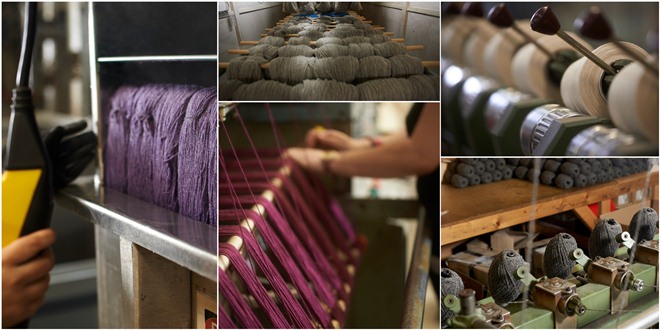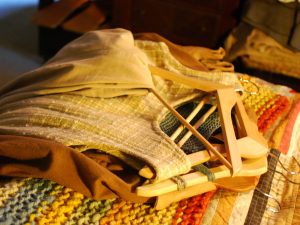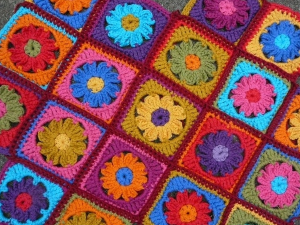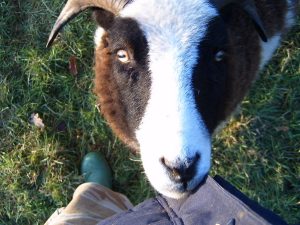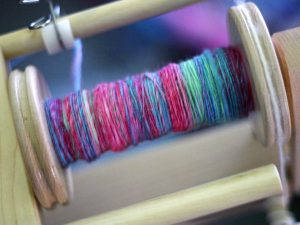Sue Blacker takes us on a final tour of The Natural Fibre Company’s spinning mill to learn all about labelling yarn. Turns out there’s plenty to it!
To be honest, labelling is possibly even more complicated than actually making yarns. And of course we cannot spin yarns about our yarns. Well, we can and do in describing the concepts, ideas and thinking behind designing a yarn, but not when describing the dimensions, weight and composition! Also labels full of technical information are not particularly photogenic, though we do try our best with Blacker Yarns ball-bands.
For semi definitive information, please refer to this document, although it specifically says one should read the legislation and that it is only guidance. Your local Trading Standards people are generally knowledgeable and helpful.
However, our favourite paragraph of this guidance can be found on page 7:
12. The fibre name ‘wool’ can be used to describe either fibre obtained from sheep’s or lambs’ fleeces or a mixture of such fibres and certain fine animal hairs (viz alpaca, llama, camel, cashmere, mohair, angora, vicuna, yak, guanaco, beaver, otter). The indication ‘100% wool’ may describe a mixture of, say, fibre from sheep’s or lambs’ fleeces and cashmere, though if the cashmere accounted for the greater percentage by weight of the product, it would make sense for the higher quality and more expensive cashmere fibre to be named separately, e.g. ’60% cashmere, 40% wool’ and ‘100% wool’ are equally permissible.
What more can one say?
Well, how about:
You don’t have to show particular information on the label for every kind of product, but if you include it you must be accurate. There are special rules for some products, and for retailers.
This comes from this page of the UK government website covering labelling laws so it must be right!
So there are requirements about composition: under EU regulation, each yarn label must include the quantities of each type of fibre in that yarn: wool, silk, linen, nylon, alpaca, mohair, etc. There is no requirement to say it is pure new wool, or that it comes from a specific breed, farm or area unless, like the Shetland Organic Wool, it has obtained an EU product origin certification. So the really interesting information is added for marketing purposes and not for compliance!
Organic yarns have specific labelling requirements, including the certificate number of the producer and processor and again the proportions of organic or other fibre. It is not permitted to mix organic and non organic wool because the DNA tests cannot yet distinguish them, so it is only permitted to add a different fibre than wool to an organic blend, which is allowed to have either 5% or 30% of non organic fibre. There is a large and detailed manual of the rules for organic labelling, including the size of the logo to be used, so organic does cost a bit more to manage even at this stage.

Organic processing is managed separately so that all machines touched by organic fibre are clean and no cross contamination is possible from non organic fibre. This takes even more careful management than just making sure each customer’s wool batch integrity is maintained, and is why we generally only work on organic processing once or twice a year.

There is an interesting challenge about composition in that the most practical and accurate measurement is made when blending dry scoured fibre or tops. If tops, then generally the proportions should be the same in the ball or skein, but if from dry, scoured weight, the combing process and then spinning may drop a slightly higher proportion of one component than the other. Also of course there is the small mathematical challenge that adding 10kg of mohair, say, to 100kg of wool makes a different composition than adding 10kg to 90kg, which sometimes challenges those who hate percentages! This is easy with these numbers, but less so with, say a 15kg starting point!
Then comes the weights and measures information: the weight of the package must be given, in grams (for the UK and EU). This must be on average the same for every ball or skein in a batch and is within strict tolerances. Again, we are not required to provide the length, WPI, tension, recommended needle sizes or whether the yarn is a particular ply or thickness! We do of course provide all of this additional information, along with basic care information, because this is what the customer wants.
Then comes the origin: we have already said that no individual holding details are required, other than for marketing purposes, but we do need to say made in the UK, particularly for the US market. We also give our name and address, and it is helpful to provide the phone, email and web address information, and we have a Made in Cornwall certification as well. As we do not buy wool through British Wool, we cannot use their labelling other than as a Supporter under their new rules, even though all of our yarns except those from Falkland wool is usually more pure British in composition than the rules for some parts of the British Wool scheme. Because we make everything in-house, it is easier for us than for those who may source things from many places or process in many places, not all in a single country. This of course is why Brexit is such fun!
So that is why there is so much information on ball-bands and skein bands or tags. The rules actually require relatively little, while the customers, quite rightly, require considerably more in order to understand and justify their investment in a special, high quality product which is not cheap. For example, it really does help for us to put “spun by The Natural Fibre Company” on the yarns we spin for customers, because sometimes we can find them when a person wants an extra ball and cannot locate or contact them.
 About the author
About the author
As British wool spinners, The Natural Fibre Company add value by processing quantities of fleece from 20 kilograms up to over a tonne and more. As we scour, card, dye and woollen and worsted spin under one roof, we are effectively experts in all aspects of the process of turning raw fleece into high quality yarn. Most of our customers are in the UK for rare and specialist breeds.

